Homesteading Alone
How to build a wilderness home
The uber American dream is to build your own comfy place on the edge of wilderness with your own hands. The attraction of this self-reliance is the chance to rewind civilization personally, to start over and do it your way. To own your own progress. Thoreau wrote the prime document of lifestyle self-reliance in his shed at Walden pond, an hour’s walk away from his home. Walden is still worth reading as a how-to and why-to book. Yet as the world’s wilderness shrinks, each generation seeks the wild further afield in order to retell the story of sprouting kernel of humanity in a small homestead.
There’s a lot to be learned from the few diehards who have homesteaded far off the grid in modern times, and who have written honestly about the practicalities of this adventure. I found three recent accounts to be most helpful. Listening to them you get to see how much of a subsidy civilization gives us, and how challenging it is to recreate it in even a small measure.
In An Island To Oneself, Tom Neale took over an uninhabited island in the Pacific in the 1950s and constructed a beach shack for his solitary home. He’s a sort of Robinson Crusoe, or Cast Away, for real. He voluntarily lived alone, separated from the nearest human by hundreds of miles of open sea. He had to be his own contractor, gardener, shipbuilder, fisherman, and doctor. The amount of household stuff he recreated from scratch is amazing. Neale had a lot of leisure as a full-time beach bum, but it’s a surprise how constantly he worked, and how thoroughly he had to prepare for everything. His account supplies great details about the reality of living on a deserted island. In a place like his the littlest mistakes could be fatal. His journal is a page turner with one small upset after another. It was no day at the beach.
In a parallel world up in the cold wilds of Alaska, Dick Proenneke flew to a remote lake and built himself a log cabin to live year-round alone among the snow, bears, and blueberries. This achievement is not uncommon for Alaska. What makes his account in One Man’s Wilderness special and useful is that Proenneke thoroughly documented his work in 16mm film movies, photos, and diaries. From his meticulously vivid accounts you get a clear and exact recipe for what it takes to chop trees with an axe, peel them by hand, and erect an airtight cabin. And then to heat it all winter in minus 30 degrees. Proenneke complicated his chores by filming and photographing himself the whole time while doing them, no easy feat with bulky, balky film movie cameras of the 1970s. While his “video” clips are fascinating, I found his journal far more helpful, more impressive, and more inspirational. One Man’s Wilderness is a great account of how to build a tidy cabin from logs you cut and hew, and keep warm and content in the northern wilderness.
Somewhat related to the Alaska romance is the story of Sylvan Hart, who called himself the last mountain man. In the 1960s and 70s Hart homesteaded in a remote part of Idaho. He lived near a road, and had neighbors and mail delivery, but he spent a lot of time making his own tools, and practicing what are now called primitive survival skills. He mined copper, made metal, forged iron, made his own guns, and hunted bear for food and clothing. In other words he was trying to bootstrap civilization as much as he could. His story, written by a sympathetic journalist in the book The Last Mountain Man, gives a somewhat romantic picture of Hart’s life, but even this dramatic view will quell most fantasies with how bootstrapping it is.
Yes, you can build a home in the wilderness using only hand tools, but as all each of these stories make clear, self reliance is relative. Thoreau went to town to do his laundry, Neale brought a boatload of supplies with him, and Proenneke in Alaska had the bulk of his food flown in every month. The larger lesson from these books, and the reason they are cool tools, is that every small step we take toward self reliance is rewarded with heaps of wholeness, self-knowledge, and personal clarity. These books will give you confidence and tips on taking your own small steps toward doing things yourself.
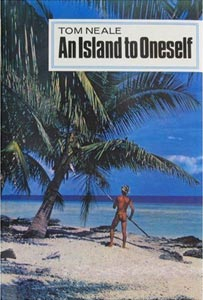
An Island to Oneself
Tom Neale
1966 (1990), 255 pages
$25
Available from Amazon
On August 4, 1953 — ten months after I had landed — I welcomed my first visitors.
It was unexpected because I had long since stopped wondering whether one day I would wake up to discover a strange yacht or schooner anchored in the lagoon. I had become so engrossed with my life on Suvarov that I rarely gave a thought to the outside world.
They were very happy days. I was never lonely, though now and again I would walk along the reef wishing somebody could be with me — not because I wanted company but just because all this beauty seemed too perfect to keep to myself.
*

Fishing in the shallows with a single pronged spear.

The evening’s haul. I was never short of fish.
*
Of course, I had heard of this great lagoon, with its coral reef stretching nearly fifty miles in circumference, but I had never been there, for it was off the trade routes, and shipping rarely passed that way.
Because its reef is submerged at high tide — leaving only a line of writhing white foam to warn the navigator of its perils — Suvarov, however, is clearly marked on all maps. Yet Suvarov is not the name of an island, but of an atoll, and the small islets inside the lagoon each have their own names. The islets vary in size from Anchorage, the largest, which is half a mile long, to One Tree Island, the smallest, which is merely a mushroom of coral. The atoll lies in the centre of the Pacific, five hundred and thirteen miles north of Rarotonga, and the nearest inhabited island is Manihiki, two hundred miles distant.
*
Morning and evening from that moment on I scattered the split uto nuts on the square of ground where the run was to be built, and then banged lustily on the old iron crowbar made from the transmission shaft of a Model T Ford I had acquired in a Raro junkyard. The result was really extraordinary. Up till now I had spent weeks unsuccessfully trying to cajole the fowls into a regular feeding tie. Now, within a week, they were recognizing the familiar sound of the beaten crowbar, and cam running as fast as they could, determined not to miss a good feed. They brought all sorts of surprises with them too — in the shape of at least two clutches of chicks which I had no idea even existed. Although this achievement did not immediately solve my egg-collecting problems, at least I was able to keep track of the island’s hen population, and now I started building the chicken run in earnest.
*
I knew the portents only too well (that trite old phrase about the calm before the storm) and strode back to the shack. There was no immediate hurry — but equally there was no doubt that serious trouble was on the way. Before doing anything else, I checked my survival cache of tools, making sure my extra matches in their sealed tin were dry, and then took the box over to the “burial hole” in the outhouse. Next I lit a good fire on my brick hearth, and while it was burning, went out with my spear for a concentrated hour of fishing. It seemed provident to lay in some emergency rations, for there was no telling with a big storm; it could last a few hours or a few days.
I had plenty of cooked uto, but I foraged around for a couple of dozen more, which I cooked, and then I laid out double rations for the fowls. Next — as the first puffs of wind ruffled the palms — I inspected the garden for any ripe fruit which would be mercilessly blown off the plants when the inevitable storm broke.
I had sufficient uto to withstand a siege of several days — and in a way it was rather like preparing for a siege against an implacable foe. In the outhouse I had a plentiful supply of wood, and in the kai room a good stock of arrowroot, plenty of fresh vegetables, including yams, cucumbers, tomatoes, spinach and onions. A dozen drinking nuts, a couple of ripe breadfruit and a stem of bananas completed my emergency rations.
By mid-afternoon gigantic seas were visible breaking all along the reef to the north, and before sunset, when the storm was beginning to reach its height, seas more huge than I had ever seen before began breaking right across the half-mile width of the entrance to the passage.
*
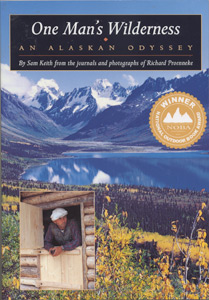
One Man’s Wilderness
Sam Keith, from the journals and photographs of Richard Proenneke
1999 (2010), 223 pages
$12
Available from Amazon
Sample excerpts:
Learn to use an axe and respect it and you can’t help but love it. Abuse one and it will wear your hands raw and open your foot like an overcooked sausage. Each blade was nursed to a perfect edge, and the keenness of its bright arc made my strokes more accurate and more deliberate. No sloppy moves with that deadly beauty! Before I started on a tree I carefully cleared obstructions that might tangle in the backswing. It was fun planning where each should fall, and notching it for direction. Snuck! Snuck! The ax made a solid sound as it bit deeply into the white wood.
*
Anyone living alone has to get things down to a system — know where things are and what the next move is going to be. Chores are easier if forethought is given to them and they are looked upon as little pleasures to perform instead of inconveniences that steal time and try the patience.
*
I included in the first trip a .30-06 converted Army Springfield, a box of cartridges, a .357 magnum pistol with cartridge belt and holster, the backboard, the camera gear (8mm movie and 35mm reflex), cartons of film, the foodstuffs (oatmeal, powdered milk, flour, salt, pepper, sugar, honey, rice, onions, baking soda, dehydrated potatoes, dried fruit, a few tins of butter, half a slab of bacon), and a jar of Mary Alsworth’s ageless sourdough starter.
The second pile consisted of binoculars, spotting scope, tripod, a double-bitted axe, fishing gear, a sleeping bag, packages of seeds, A Field Guide to Western Birds, my ten-inch pack, and the clothing. More bulk than weight.
The third pile held the hand tools such as wood augers, files, chisels, drawknife, saws, saw set, honing stone, vise grips, screwdrivers, adze, plumb bob and line, string level, square, chalk, chalk line, and carpenter pencils; a galvanized pail containing such things as masking tape, nails, sheet metal screws, haywire, clothesline, needles and thread, wooden matches, a magnifying glass, and various repair items; a bag of plaster of Paris; and some oakum.
*
It is always interesting to see what a fish has been eating. Several times I have found mice in the stomachs of lake trout and arctic char. Now how does a mouse get himself into a jackpot like that? Does he fall by accident, or does he venture for a swim? tough to be a mouse in this country.
*
It is important to put the notch on the underside of a log and fit it down over the top of the one beneath. If you notch the topside, raid will run into it instead of dripping past in a shingle effect. Water settling into the notches can cause problems.
*
Had my first building inspector at the job. A gray jay, affectionately known as camp robber, came in his drab uniform of gray and white and black to look things over from his perch on a branch end. The way he kept tilting his head and making those mewing sounds, I’d say he was being downright critical.
*
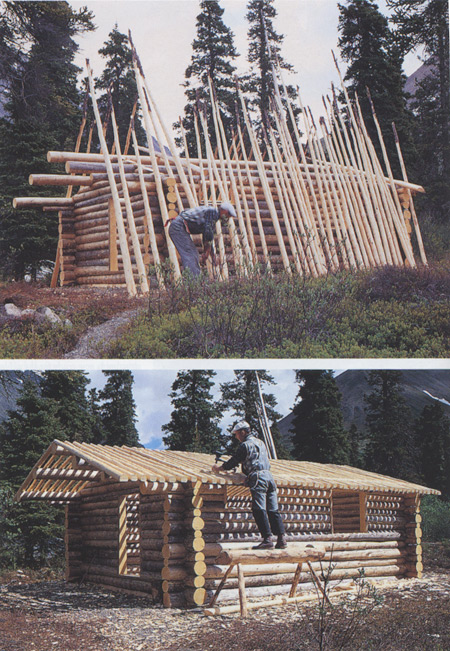
1) These simple hand tools will challenge anyone’s self-reliance. 2) Notice how the notches fit snugly over the tops of the logs below them, as if fused.
*
1) Dick readies the roof poles for installation. 2) With the poles in place, the slots between the pole ends under the eaves need to be filled in. These fillers should be called “squirrel frustraters.”
*
Wood to saw and split everyday. Got to keep up my payments at the Firewood Trust if I want to stay warm this winter. No real problem at all. Some folks had led me to believe it would be an everlasting job — cut wood all day to keep warm all night.
*
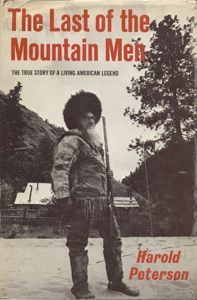
The Last of the Mountain Men
Harold Peterson
1969, 160 pages
$12
Available from Amazon
Sample excerpts:
As a young man, dismayed by the destruction of the final frontiers, Sylvan Hart recanted civilization and marched off into this Idaho fastness armed with a few staples, an ax, a rifle, and a master’s degree in engineering. There, in the last wilderness, where one winter’s snow might fall into another’s before a visitor came, he became the last of the Mountain Men. Son to be known as Buckskin Bill, he fashioned his own clothes of deerskin. He constructed adobe-covered building with hand-hewn timbers. He mined copper, smelted it, refined it, and made utensils. He even made his own flintlock rifles, boring them on an ingenious handmade machines, to “save the bother of sore-bought ammunition.” To pay for infrequent trips to Burgdorf (pop. 6, in winter 0), where he purchased only powder, books, and Darjeeling tea, he panned gold.
*
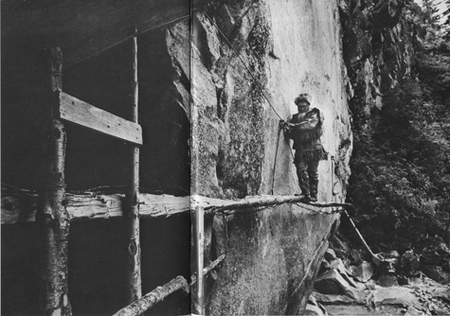
Sylvan’s pole bridge, pinned precariously to the sheer face of a cliff high above the roiling River of No Return, constitutes the only path to the outside world.








